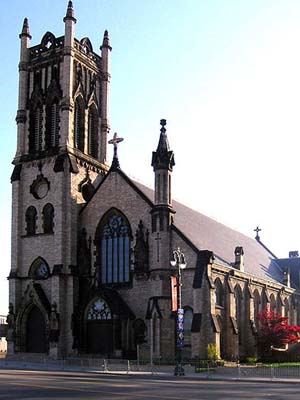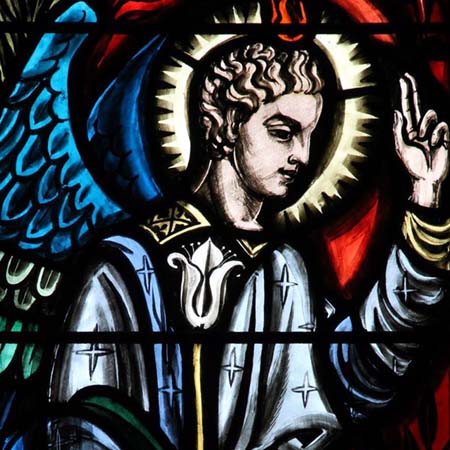| |
 |
 |
 |
| Comment on this report, or find other reports. |
 |
| Our Mystery Worshippers are volunteers who warm church pews for us around the world. If you'd like to become a Mystery Worshipper, start here. |
 |
| Find out how to reproduce this report in your church magazine or website. |
|
|
| 2815: St John's, Detroit, Michigan, USA |
 |

Photo:
© Andrew Jameson and used under license
|
 |
Mystery Worshipper: High Tory.
The church: St John's, Detroit, Michigan, USA.
Denomination: The Episcopal Church, Diocese of Michigan.
The building: St John's was founded in 1858 with the now-chapel opening as the original church structure in 1859. The chapel proved too small, so the present church was constructed and was consecration in 1861. The architecture is Victorian Gothic with some original stained glass and a circa 1890s high altar. The church is physically large and is as big as many cathedrals. It is listed on the National Register of Historic Places. A detailed description of the building can be found on their website.
The church: St John's uses the 1928 American edition of the Book of Common Prayer, which is very rare in today's Episcopal Church. It is a diverse congregation with many commuters from far-flung Detroit suburbs, as it is a fairly conservative Episcopal parish – politically and theologically. They sponsor a chapter of the Brotherhood of St Andrew as well as the Confraternity of the Blessed Sacrament. There is also a group for young adults in their 20s who (quoting from their website) strive to "develop good friendships and have a good time, all the while more fully getting to know Jesus Christ and learn about the Christian faith." They have morning prayer and two services of holy communion each Sunday, plus holy communion and evening prayer on Mondays through Thursdays. The Wednesday holy communion service includes a rite of healing. Adoration is held on Thursdays.
The neighborhood: This is a pre-American Civil War church that has seen the best and worst of Detroit in its relatively long, at least by American standards, history. It is located on Woodward Avenue, one of Detroit's principal arteries, once a broad boulevard of elegant stores and upscale homes and the location of the last of Detroit's streetcar lines (discontinued in 1956, although a new light rail line has been proposed). This is a fascinating part of Detroit, as it’s in the midst of a total renewal. At present, St John’s shares a parking lot with the stadium of the Detroit Tigers baseball club. It’s also about two blocks from Ford Field, where the NFL’s Detroit Lions play. Also across the way is the site of the soon-to-be-built arena for the Detroit Red Wings, the National Hockey League team. The church is located in what was once called Piety Hill (or Amen Alley by the more secular crowd), named after the large number of churches located there – something of a misnomer, actually, as scantily concealed houses of pleasure coexisted with the houses of worship.
The cast: The Revd Steven J. Kelly, SSC (Society of the Holy Cross), rector. There were also a deacon, crucifer and thurifer in the procession, along with a full choir.
The date & time: February 1, 2015, 10.00am.
Comment:
We have received a comment on this report.
What was the name of the service?
Holy Communion.
How full was the building?
Mostly empty – perhaps 100 people the seating for upwards of 800 – though, in fairness, there was an overnight winter blizzard that had wreaked havoc in Detroit.
Did anyone welcome you personally?
An usher wished me a good morning, shook my hand, and handed me an order of service.
Was your pew comfortable?
Reasonably comfortable. Having an entire pew to yourself makes it even more comfortable.
How would you describe the pre-service
atmosphere?
Somber. All of the congregants were quiet. Some prayed on kneelers. Others sat in silence, staring at the altar or marking various pages in the hymnal or Prayer Book. The organist struck up a rather short prelude: “Tierce en taille” from Suite du Deuxième Ton by the 18th century Franco-German organist and harpsichordist Jean-Adam Guilain.
What were the exact opening words of the
service?
"Let us pray."
What books did the congregation use during the
service?
1928 Book of Common Prayer and 1942 Hymnal.
What musical instruments were played?
Organ. Originally built by Hutchings-Votey Organ Co. of Boston, it was rebuilt by Casavant Frères Ltée in 1965 as their Opus 1550-R. Daniel F. Pilzecker Organ Bldrs of Toledo, Ohio, revoiced some of the stops and rebuilt the console in 1988 and made further changes in 2000.
Did anything distract you?
The ornate high altar and stained glass windows at times were actually distracting, as my eye wanted to take in all the details of this Victorian Gothic church.

Was the worship stiff-upper-lip, happy clappy, or
what?
Stuff-upper-lip without being obnoxiously pretentious. The rector is extremely high in his churchmanship – he faces east, for example. I saw him shut off his microphone at one point and then saw a lot of manual acts being performed at the high altar. Many in the congregation genuflected and bowed and crossed themselves, but I also spotted a fair number of broad church and even low church Episcopalians who did not follow the lead of their fellow congregants. They presumably go here because of its traditional liturgy and conservative theology, not because they're Anglo-Catholic.
Exactly how long was the sermon?
10 minutes, but it wasn't a sermon.
In a nutshell, what was the sermon
about?
The rector gave his annual report as a prelude to the annual parish meeting that was to take place after the service in the undercroft.
Which part of the service was like being in
heaven?
The classic Prayer Book liturgy, in particular the sursum corda or great thanksgiving.
And which part was like being in... er... the other place?
The post-service itself, as the coffee can only be described as poor (see below) and nobody seemed really to care about greeting newcomers.
What happened when you hung around after the service looking lost?
Nobody approached me in the pew, so I made my way to the back of the nave where the deacon was greeting departing congregants. There was also a line to get past the rector, who took up a post just past him by the side door and the stairs to the undercroft. I shook the deacon’s hand and exchanged brief pleasantries with him. The rector also shook my hand and invited me downstairs to the undercroft.
How would you describe the after-service
coffee?
Very cheap coffee and grocery store snacks were served in the undercroft. There was soup, but I didn't have any.
How would you feel about making this church your regular (where 10 = ecstatic, 0 = terminal)?
8 – The churchmanship is a little too Anglo-Catholic, but I would very much see myself as a member here.
Did the service make you feel glad to be a
Christian?
It was refreshing to see a church that hasn't compromised traditional Anglicanism for modern worship.
What one thing will you remember about all this in seven days' time?
The traditional worship. |
|
|
 |
 |
 |
| We rely on voluntary donations to stay online. If you're a regular visitor to Ship of Fools, please consider supporting us. |
 |
 |
 |
| The Mystery Pilgrim |
 |
| One of our most seasoned reporters makes the Camino pilgrimage to Santiago de Compostela in Spain. Read here. |
 |
 |
 |
| London churches |
 |
| Read reports from 70 London churches, visited by a small army of Mystery Worshippers on one single Sunday. Read here. |
| |
|
|
|
|


